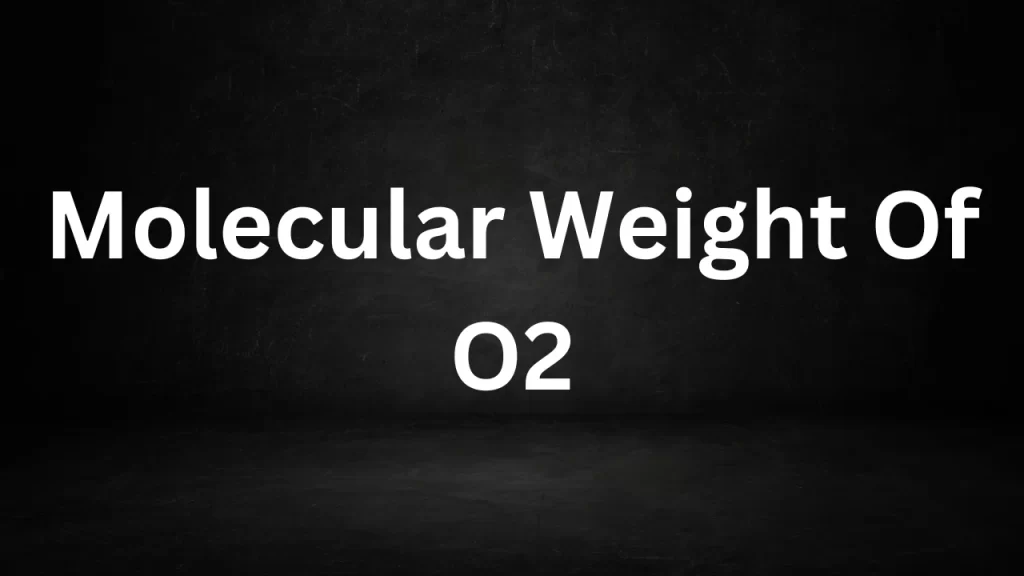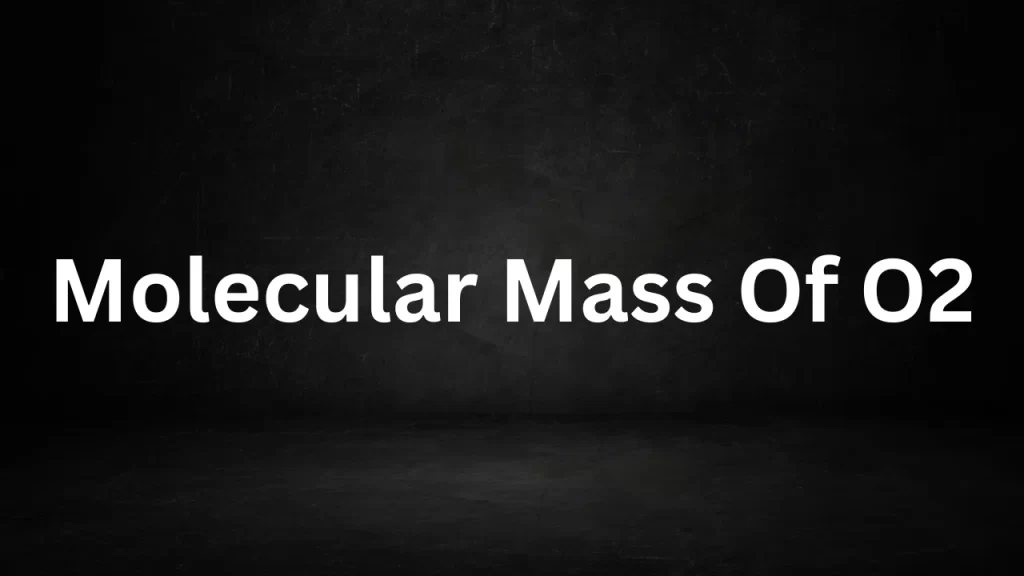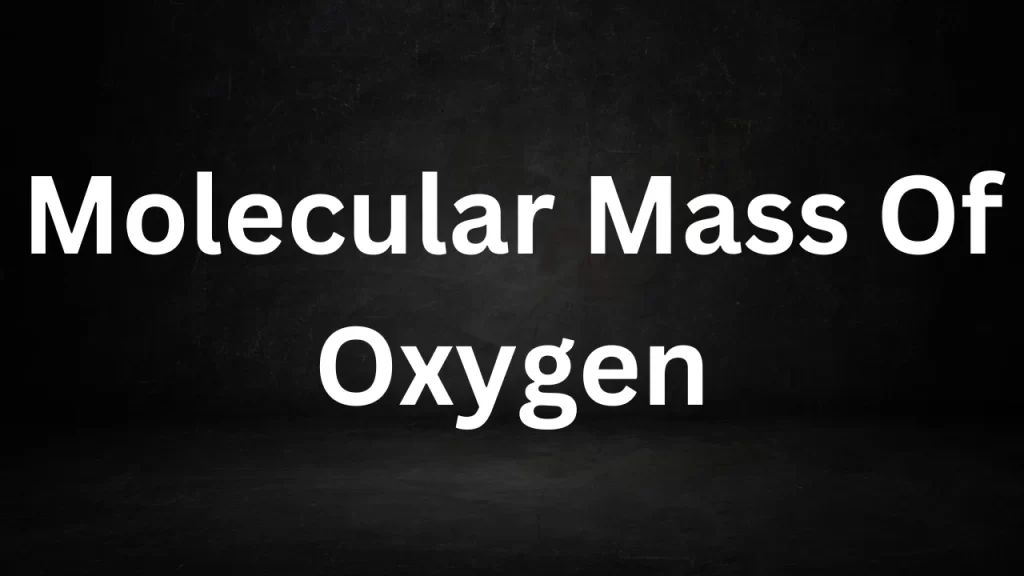Tag: o2 molar mass
Molecular Weight Of O2
Molecular Weight Of O2: Oxygen is a vital element for life on Earth, and it plays a crucial role in various chemical reactions and processes. In the realm of chemistry, understanding the mole weight of oxygen, specifically as O2 (diatomic oxygen), is fundamental.
In this article, we will explore what mole weight is, how it relates to O2, and its significance in both theoretical and practical contexts.

Molecular Weight Of O2
What Is Molecular Weight?
Mole weight, also known as molar mass, is a fundamental concept in chemistry. It represents the mass of one mole of a particular substance and is typically expressed in grams per mole (g/mol). A mole is a unit used to quantify the amount of a substance and contains approximately 6.022 x 10^23 entities, known as Avogadro’s number. Molecular weight is numerically equivalent to the atomic or molecular weight of the substance.
Understanding O2 (Diatomic Oxygen)
Oxygen, in its molecular form, exists as a diatomic molecule, O2. This means that each molecule of O2 consists of two oxygen (O) atoms bonded together. To calculate the molecular weight of O2, we need to sum the atomic masses of these two oxygen atoms.
Oxygen (O) has an atomic mass of approximately 16.00 g/mol. Therefore, to find the mole weight of O2 (diatomic oxygen), we simply add the atomic masses of the two oxygen atoms:
Mole Weight of O2 = 2 x Atomic Mass of O
Mole Weight of O2 = 2 x 16.00 g/mol = 32.00 g/mol
So, the mole weight of O2 (diatomic oxygen) is approximately 32.00 g/mol.
Significance of Molecular Weight of O2
- Chemical Reactions: Understanding the molecular weight of O2 is essential in various chemical reactions where oxygen is involved as a reactant or product. It helps in stoichiometry, which is the study of the quantitative relationships between reactants and products in chemical reactions.
- Gas Laws: In the field of gas laws, the mole weight of O2 is crucial for determining the behavior of oxygen gas under different conditions of temperature and pressure. It contributes to calculations involving the ideal gas law and other gas-related concepts.
- Environmental Sciences: Mole weight plays a role in environmental sciences, especially in the measurement of air quality and the composition of Earth’s atmosphere, where O2 is a significant component.
- Industrial Applications: In industrial processes, the mole weight of O2 is important for precise calculations and control of reactions involving oxygen, such as combustion processes in power generation and metal smelting.
Conclusion
The mole weight of O2 (diatomic oxygen) is a fundamental concept in chemistry that holds significance in a wide range of scientific and practical applications. It aids in understanding chemical reactions, gas behaviors, environmental studies, and industrial processes. By grasping this concept, scientists and professionals can make informed decisions and contributions in various fields, furthering our understanding of oxygen’s role in the natural world and human endeavors.
Read More
- Calcium Carbonate Molar Mass
- Molar Mass Of Ammonia
- Molecular Mass Of Acetic Acid
- Molecular Weight Of Calcium Carbonate
- Molecular Weight Of Sodium Hydroxide
Frequently Asked Questions (FAQs) Molecular Weight Of O2
1. What is the molecular weight of O2 (diatomic oxygen)?
The mole weight of O2, which represents diatomic oxygen, is approximately 32.00 grams per mole (g/mol).
2. Why is the molecular weight of O2 important in chemistry?
The mole weight of O2 is essential in chemistry because it helps in stoichiometry, allowing chemists to determine the quantities of oxygen involved in chemical reactions. It also plays a role in gas laws and various practical applications.
3. How is the molecular weight of O2 calculated?
To calculate the mole weight of O2, you simply add the atomic masses of the two oxygen (O) atoms in the O2 molecule. Each oxygen atom has an atomic mass of approximately 16.00 g/mol, so the calculation is: Molecular Weight of O2 = 2 x Atomic Mass of O.
4. What is the significance of knowing the molecular weight of O2 in gas laws?
The mole weight of O2 is crucial in gas laws, such as the ideal gas law, because it helps determine the behavior of oxygen gas under different conditions of temperature and pressure. It contributes to calculations involving the behavior of gases.
5. In environmental sciences, why is the molecular weight of O2 important?
Understanding the mole weight of O2 is significant in environmental sciences when studying air quality and the composition of Earth’s atmosphere. O2 is a major component of the atmosphere, and its mole weight is relevant in atmospheric research.
Molecular Mass Of O2
Molecular Mass Of O2: Oxygen, an essential element for life as we know it, exists primarily in the form of a diatomic molecule, O2, known as oxygen gas. In this article, we will explore the molecular mass of oxygen gas (O2), its significance in chemistry and biology, and its vital role in supporting life on Earth.

Molecular Mass Of O2
The Life-Sustaining Element: Oxygen
Oxygen, with the chemical symbol O and atomic number 8, is the third-most abundant element in the universe and the most abundant element in the Earth’s crust. It is a critical component of the Earth’s atmosphere, making up approximately 21% of the air we breathe. Oxygen is essential for respiration in most living organisms, serving as a key player in the processes that produce energy from food.
Molecular Structure of Oxygen Gas
Before discussing the molecular mass of oxygen gas, it’s important to understand its molecular structure. Oxygen gas consists of two oxygen (O) atoms bonded together, forming a diatomic molecule, O2. This diatomic molecule is the most common form of molecular oxygen found in the Earth’s atmosphere.
Molecular Mass of Oxygen Gas (O2)
The molecular mass of a compound, often referred to as its molar mass, is defined as the mass of one mole of molecules of that compound, measured in grams per mole (g/mol). To calculate the molecular mass of oxygen gas (O2), we sum the atomic masses of its constituent atoms:
- Oxygen (O) has an atomic mass of approximately 16.00 g/mol.
- Now, let’s calculate the molecular mass of oxygen gas:
- Molecular Mass of Oxygen Gas (O2) = (2 × Atomic Mass of Oxygen)
- Molecular Mass of Oxygen Gas (O2) = (2 × 16.00 g/mol)
- Molecular Mass of Oxygen Gas (O2) ≈ 32.00 g/mol
- So, the molecular mass of oxygen gas is approximately 32.00 grams per mole.
Significance of Molecular Mass in Chemistry and Biology
The molecular mass of oxygen gas is a fundamental value in both chemistry and biology. In chemistry, it is used for stoichiometry, chemical calculations, and the formulation of chemical equations. In biology, understanding the molecular mass of oxygen gas is crucial for comprehending the processes of respiration, where oxygen is used by cells to generate energy.
Conclusion
The molecular mass of oxygen gas (O2), approximately 32.00 g/mol, underscores the importance of this diatomic molecule in supporting life on Earth. From the air we breathe to the energy-producing reactions occurring within our cells, oxygen gas plays a central role in the biology and chemistry of our planet. Its molecular mass serves as a foundation for understanding the processes that sustain life and drive chemical reactions in the natural world.
Read More
- Molecular Mass of H2
- Molecular Mass Of NH3
- Molecular Mass Of Ch4
- Nitric Acid Molar Mass
- Molar Mass of Helium
Frequently Asked Questions (FAQs) Molecular Mass Of O2
Q1: What is the molecular mass of O2 (oxygen gas)?
A1: The molecular mass of O2 (oxygen gas) is approximately 32.00 grams per mole (g/mol).
Q2: Why is the molecular mass of oxygen gas important in chemistry and biology?
A2: The molecular mass of oxygen gas is important because it allows chemists to determine the mass of one mole of oxygen gas molecules, which is essential for stoichiometry, chemical calculations, and the formulation of chemical reactions. In biology, it is crucial for understanding processes like respiration, where oxygen is used by living organisms to generate energy.
Q3: Is oxygen gas the only form of oxygen in the Earth’s atmosphere?
A3: No, oxygen gas (O2) is the most abundant form of oxygen in the Earth’s atmosphere, making up about 21% of the air we breathe. However, there is also a trace amount of another form, ozone (O3), which is found in the ozone layer in the upper atmosphere and plays a critical role in protecting life on Earth from harmful ultraviolet (UV) radiation.
Q4: How is oxygen gas produced for industrial and medical purposes?
A4: Oxygen gas for industrial and medical purposes is often produced through processes such as fractional distillation of air or by electrolysis of water. In fractional distillation, air is cooled and compressed to separate its components, with oxygen being one of the products. Electrolysis of water involves passing an electric current through water to split it into hydrogen and oxygen gases.
Q5: What happens when oxygen gas is inhaled by living organisms?
A5: When oxygen gas is inhaled, it is transported by the circulatory system to cells throughout the body. Inside cells, oxygen is used in metabolic processes, particularly in the mitochondria, to generate energy through aerobic respiration. The waste product of this process is carbon dioxide (CO2), which is then expelled from the body when we exhale.
Molecular Mass Of Oxygen
Molecular Mass Of Oxygen: O2, often symbolized as O2, is the life-sustaining element that makes up a substantial portion of Earth’s atmosphere. Its importance in respiration, combustion, and various chemical processes is undeniable.
To fully grasp the significance of oxygen, it’s essential to understand its molecular mass, a fundamental property that reveals its weight and behavior in the natural world.

Molecular Mass Of Oxygen
Defining Molecular Mass
Molecular mass, also known as molecular weight or molar mass, is a measure of the total mass of a molecule. In the case of O2, this refers to the combined mass of the two O2 atoms that form a diatomic molecule. Molecular mass is typically expressed in atomic mass units (amu) or grams per mole (g/mol).
Calculating the Molecular Mass of Oxygen (O2)
To determine the molecular mass of O2, we must consider the atomic masses of the individual O2 atoms. The atomic mass of an element is defined relative to the mass of a carbon-12 atom, which is assigned a mass of exactly 12 atomic mass units (amu).
The atomic mass of O2 is approximately 15.9994 amu. Since O2 molecules consist of two O2 atoms, we can calculate the molecular mass of O2 as follows:
Molecular Mass of O2 = (Atomic Mass of O) * 2
Molecular Mass of O2 = (15.9994 amu) * 2
Molecular Mass of O2 ≈ 31.9988 amu
Hence, the molecular mass of O2 is approximately 31.9988 atomic mass units.
The Significance of Molecular Mass
Understanding the molecular mass of O2 is crucial in various scientific and practical applications:
1. Respiration:
- In the field of biology, the molecular mass of O2 is essential for calculating the amount of O2 consumed during respiration. This information is vital for understanding metabolic processes in organisms.
2. Stoichiometry:
- Chemists use molecular masses extensively in stoichiometry, where they calculate reactant and product masses in chemical reactions. This knowledge helps in determining reaction yields and balancing chemical equations.
3. Gas Laws:
- In the study of gases, such as in the ideal gas law, the molecular mass of O2 is a key parameter for predicting gas behavior under various conditions of temperature and pressure.
4. Environmental Science:
- Molecular mass plays a role in environmental studies, including air quality assessments. It helps in determining the composition of Earth’s atmosphere and monitoring changes due to pollution.
5. Industry and Technology:
- In industrial processes like combustion, the molecular mass of O2 is essential for optimizing fuel-air mixtures and ensuring efficient energy production.
Conclusion
The molecular mass of O2 is approximately 31.9988 atomic mass units, revealing its weight in chemical reactions, biological processes, and everyday applications.
This fundamental property allows scientists, engineers, and researchers to better understand and harness the power of O2, a vital element for life on Earth and an essential component in the world of chemistry and physics.
Read More
- Difference Between Light Microscope And Electron Microscope
- Molar Mass Of Aluminium
- Molecular Mass Of Glucose
- Latent Heat Of Water
- Difference Between Work And Power
Frequently Asked Question (FAQs) Molecular Mass Of Oxygen
1. What is the molecular mass of oxygen (O2)?
The molecular mass of oxygen (O2) is approximately 31.9988 atomic mass units (amu).
2. How is the molecular mass of oxygen calculated?
The molecular mass of oxygen (O2) is calculated by adding together the atomic masses of its constituent O2 atoms. Since O2 atoms have an atomic mass of approximately 15.9994 amu, the molecular mass of O2 is 2 times this value (2 * 15.9994 amu).
3. Why is knowing the molecular mass of oxygen important?
Understanding the molecular mass of O2 is essential in various scientific and practical applications. It is used in biology to calculate O2 consumption during respiration, in chemistry for stoichiometry and reaction balancing, and in environmental science for air quality assessments, among other uses.
4. Is the molecular mass of oxygen the same as its molar mass?
Yes, the molecular mass of O2is often referred to as its molar mass. Both terms refer to the mass of one mole of O2 molecules (O2), expressed in grams per mole (g/mol) or atomic mass units (amu).
5. How does the molecular mass of oxygen impact chemical reactions involving oxygen?
The molecular mass of O2 is crucial in chemical reactions where O2 is a reactant or product. It helps determine reactant and product masses, stoichiometry, and reaction yields.